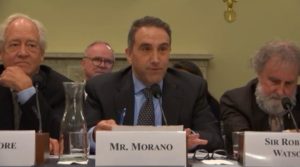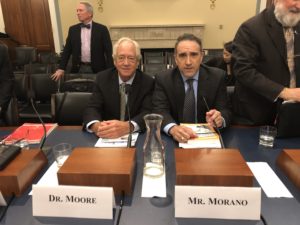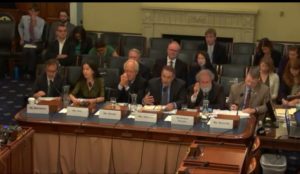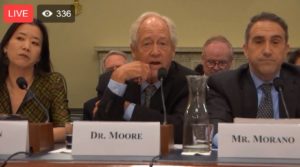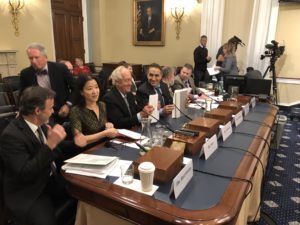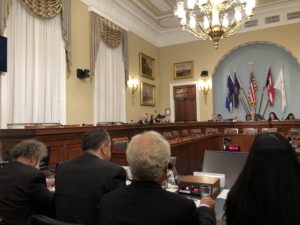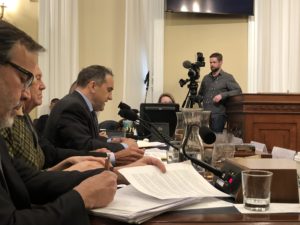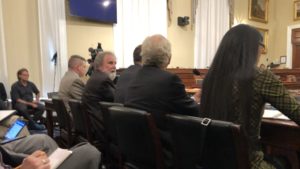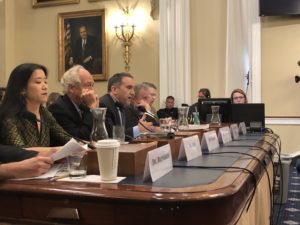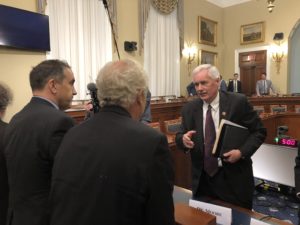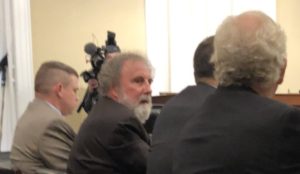Watch Full here below: Morano’s oral testimony is at 37:30 & Dr. Patrick Moore’s is at 32 min.
Submitted Written Testimony of Marc Morano, Publisher of CFACT’s Climate Depot
Author of Best Selling “The Politically Incorrect Guide to Climate Change” & former staff of U.S. Senate Environment & Public Works Committee
House Natural Resources Committee
Subcommittee on Water, Oceans, and Wildlife
Date: Wednesday, May 22, 2019
Time: 10:00 AM
Location: Longworth House Office Building 1324
Testimony is also available on Congressional website here.
I want to thank the House Natural Resources Committee for hosting this hearing on the UN species report. My background is in political science, which happens to be an ideal background for examining the latest round of UN environmental claims. I have been following the UN species reports since 2010 when the UN first announced they were going to be elevating species to near the level of climate as a concern. See: 2010: Global Warming? Never heard of it! Hollywood backing Biodiversity/Species Shift! Earth is ‘at a tipping point’, warns actor Harrison Ford at UN Biodiversity Conference
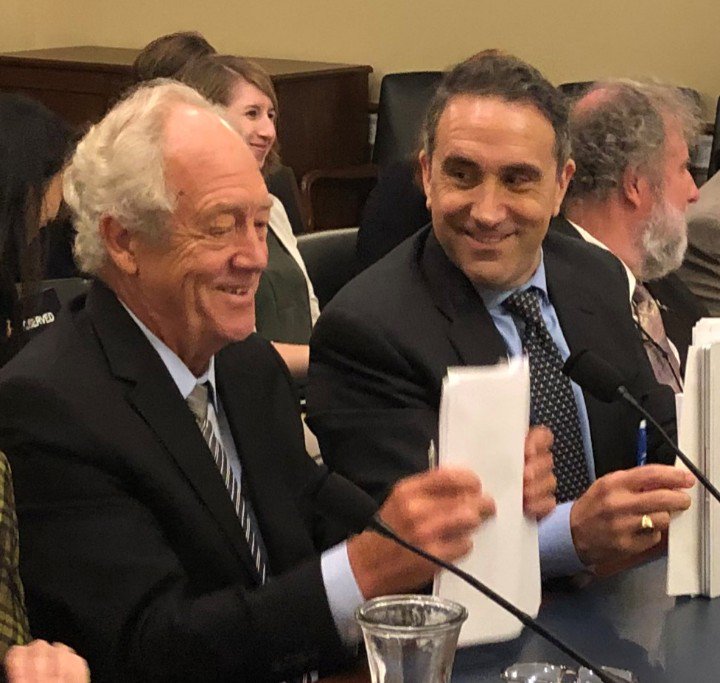
Dr. Patrick Moore & Morano during the hearing
As a lifelong conservationist, I share concerns about the Earth’s biodiversity and particularly concerns about threats to species. I have advocated for a clean, healthy planet with a co-existence of humans and plants and animals.
But, as an investigative journalist studying the United Nations for decades, there is only one conclusion to be made of this new report: The UN’s Intergovernmental Science-Policy Platform on Biodiversity and Ecosystem Services (IPBES), hypes and distorts biodiversity issues for lobbying purposes. This report is the latest UN appeal to give it more power, more scientific authority, more money, and more regulatory control.
According to media reports, the UN species report requires that “a huge transformation is needed across the economy and society to protect and restore nature…”
Morano’s opening statement to Congress holding up his book as UN’s Bob Watson (right) looks away
And just how does the UN justify this “huge transformation” of economics and society which it will lead? By invoking what the UN describes as “authoritative science” produced by — the UN of itself of course.
UN IPBES Executive Secretary, Dr. Anne Larigauderie declared: The “IPBES presents the authoritative science, knowledge and the policy options to decision makers for their consideration.”
The UN boasts it is producing “authoritative science” on biodiversity! The UN’s biodiversity’s panel claims it is representing “authoritative science.” But these unsupportable boasts will no longer be tolerated.
At best, the UN science panels represent nothing more than “authoritative bureaucracy”, claiming they hype the problem and then come up with the solution that puts them in charge of “solving” the issue in perpetuity. A more accurate term for the UN than “authoritative science” may be “authoritative propaganda.”
I am the author of the best-selling 2018 book, “The Politically Incorrect Guide to Climate Change,” reissued in 2019 with a bonus chapter on the Green New Deal. I have attended nearly every United Nations environmental summit since 2002, including the Earth Summits in Johannesburg South Africa and Rio in Brazil. I publicly debated the UN IPCC chief Rajendra Pachauri at the 2006 UN climate summit in Nairobi Kenya. I have conducted interviews with UN IPCC scientists and documented how the UN twists and hypes and distorts science in order to push a political agenda.
We know that the past UN IPCC chair, Rajendra Pachauri, declared “global warming is my religion.” Ottmar Edenhofer, former co-chair of the IPCC’s Working Group III, and a lead author of the IPCC’s Fourth Assessment Report in 2007 explains the UN agenda.
“One must say clearly that we redistribute de facto the world’s wealth by climate policy. Obviously, the owners of coal and oil will not be enthusiastic about this. One has to free oneself from the illusion that international climate policy is environmental policy. This has almost nothing to do with environmental policy anymore, with problems such as deforestation or the ozone hole.”
We know that the former UN climate chief called for a “centralized transformation” led by the UN. See: UN climate chief Christiana Figueres seeks ‘centralized transformation’ that is ‘going to make the life of everyone on the planet very different’
Figueres explained, “This is a centralized transformation that is taking place because governments have decided that they need to listen to science.” Listen to science? The UN claims to be the “authority” on the science and the UN gets to put itself in charge of the “solutions.” How convenient.
This new biodiversity report follows the same tainted IPCC procedures that the U.S. Congress must be made aware of. The report is meddled with by UN politicians, bureaucrats as part of the process.
“The report’s summary had to be approved by representatives of all 109 nations,” the AP reported. Let’s repeat, “The report’s summary had to be approved by representatives of all 109 nations.” These representatives are not scientists, but they are politicians, subject to lobbying and media pressure and their own self-interests. This is clearly a political process — not a scientific process.
This is the same hijacking of science by politicians and UN bureaucrats that has always occurred in the UN IPCC climate reports. See: UN’s alleged scientific process features “government officials” having a say in each line of the report’s summary
see page 39 of this guide to the IPBES’ internal workings
Canadian UN expert Donna Laframboise, who has written several books on the biased UN “scientific” process, explains how this new species report was crafted behind the scenes:
“[The UN] draft a summary known as the Summary for Policymakers (SPM). Then politicians and bureaucrats representing national governments attend a plenary meeting where the summary gets examined line-by-line and rewritten…But it gets worse. Over the next few weeks, the text being summarized – the underlying, ostensibly scientific document – will also get changed. That’s not how things normally work, of course. Summaries are supposed to be accurate reflections of longer documents. At the UN, they represent an opportunity to alter those documents, to make them fall into line…This is no sober scientific body, which examines multiple perspectives, and considers alternative hypotheses. The job of the IPBES is to muster only one kind of evidence, the kind that promotes UN environmental treaties.”
“That’s how the United Nations works, folks. Machinations in the shadows. Camouflaging its political aspirations by dressing them up in 1,800 pages of scientific clothing.”
Laframboise also found a serious lack of transparency in this new UN biodiversity report, giving the report “a failing grade.” See: UN Biodiversity Officials Fail Transparency Test – ‘Provides no CVs for most members of its influential panel’
Within days of the UN’s report release, major questions about the scientific claims began to emerge. See: ANALYSIS: UN’s ‘1 Million’ Extinction Warning Does Not ADD Up – ‘The word ‘suggesting’ is doing a lot of work’ – ‘We’re just supposed to take it on faith’
Analyst Toby Young: “So how exactly did the [UN] IPBES arrive at the magic one million [species at risk] number? It seems we’re just supposed to take it on faith, which the BBC duly did. What about the IPBES’s claim that ‘around 25% of species… are threatened’? That seems a little pessimistic, given that the number of mammals to have become extinct in the past 500 years or so is around 1.4% and only one bird has met the same fate in Europe since 1852. Not bad when you consider how much economic growth there’s been in the past 167 years.”
“…All I could find online was a press release put out by the IPBES and a ‘summary’ of the report ‘for policymakers’. The press release states: ‘The report finds that around one million animal and plant species are now threatened with extinction, many within decades.’ It gives no source for this beyond the as-yet-unpublished report, but the summary makes it clear that it’s partly based on data from the International Union for Conservation of Nature (IUCN) Red List of Threatened Species.”
Geologist Gregory Wrightstone just issued a scientific rebuke of the new UN species report. Wrightstone and concluded: “This new [UN] extinction study is just the latest example of misuse and abuse of the scientific process designed to sow fear of an impending climate apocalypse.”
Wrightstone called the report “a case study of how those who promote the notion of man-made catastrophic warming manipulate data and facts to spread the most fear, alarm, and disinformation.”
Wrightstone’s research instead found: “A closer review of the most recent information dating back to 1870 reveals that, instead of a frightening increase, extinctions are actually in a significant decline. What is apparent is that the trend of extinctions is declining rather than increasing, just the opposite of what the new report claims. Also, according to the IPBES report, we can expect 25,000 to 30,000 extinctions per year, yet the average over the last 40 years is about 2 species annually. That means the rate would have to multiply by 12,500 to 15,000 to reach the dizzying heights predicted. Nothing on the horizon is likely to achieve even a small fraction of that.”
Wrightstone added; “In an incredibly ironic twist that poses a difficult conundrum for those who are intent on saving the planet from our carbon dioxide excesses, the new study reports that the number one cause of predicted extinctions is habitat loss. Yet their solution is to pave over vast stretches of land for industrial-scale solar factories and to construct immense wind factories that will cover forests and grasslands, killing the endangered birds and other species they claim to want to save.”
Other analyses of the new UN report were also less than charitable.
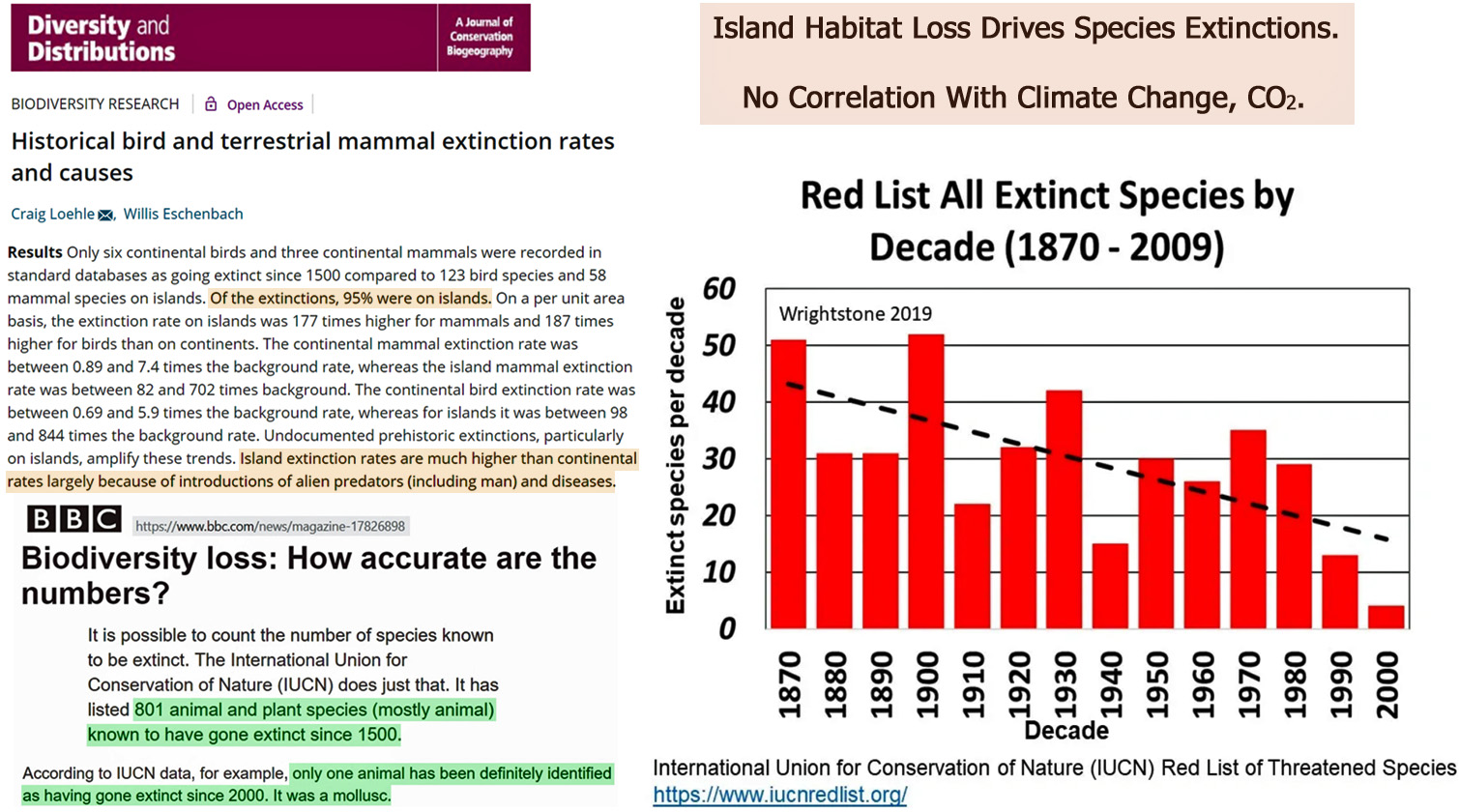
Analyst Kenneth Richard: “During the last few hundred years, species extinctions primarily occurred due to habitat loss and predator introduction on islands. Extinctions have not been linked to a warming climate or higher CO2 levels. In fact, since the 1870s, species extinction rates have been plummeting.” – “No clear link between mass extinctions and CO2-induced or sudden-onset warming events.”
As we await the full report from the UN on Biodiversity, we must note that the UN track record on species claims has not been admirable.
2014: Der Speigel’s Axel Bojanowski: “The IPCC admits that there is no evidence climate change has led to even a single species becoming extinct thus far. At most, the draft report says, climate change may have played a role in the disappearance of a few amphibians, freshwater fish and mollusks. Yet even the icons of catastrophic global warming, the polar bears, are doing surprisingly well.”
In 2010, the NY Times examined UN species claims.
See: NY Times Andrew Revkin: UN IPCC Claims About Extinction ‘confusing’ — NYT: UN IPCC Scientists “acknowledge there was inconsistency and flawed writing’ in extinction section – ‘In the Summary for Policy Makers of the report on climate impacts, there are different summations of extinction risk within a few pages.”
UN official on species in 2007: “Every hour, three species disappear. Every day, up to 150 species are lost. Every year, between 18,000 and 55,000 species become extinct. The cause: human activities. …Climate change is one of the major driving forces behind the unprecedented loss of biodiversity.” — Speech on 21 May 2007 by Ahmed Djoghlaf, then Executive Secretary of the Convention on Biological Diversity under the United Nations Environment Programme (UNEP).
Analyst Larry Kummer in 2018 counters these claims: “Those numbers are absurdly large. Also, there are many causes of species extinction. Climate change is today a far smaller factor than habitat loss and pollution (to name just two). Three decades of exaggerations like this have eroded away much of scientists’ credibility.”
Contrary scientific studies abound:
“Re-assessing current extinction rates” by Neil Stork in Biodiversity and Conservation, February 2010. Gated. Open copy. He cites the overwhelming peer-reviewed research evidence that claims of mass extinctions occurring today are exaggerated or false, and explains the reasons for these errors. Conclusions … “So what can we conclude about extinction rates? First, less than 1% of all organisms are recorded to have become extinct in the last few centuries and there are almost no empirical data to support estimates of current extinctions of 100 or even one species a day.”
“Species–area relationships always overestimate extinction rates from habitat loss” by Fangliang He and Stephen P. Hubbell in Nature, 19 May 2011. Gated. “Extinction from habitat loss is the signature conservation problem of the twenty-first century. Despite its importance, estimating extinction rates is still highly uncertain because no proven direct methods or reliable data exist for verifying extinctions.”
John C. Briggs (Prof Marine Science, U South FL) in Science, 14 November 2014. – “Most extinctions have occurred on oceanic islands or in restricted freshwater locations, with very few occurring on Earth’s continents or in the oceans.”
Perhaps the most high profile species prediction failure of the UN and former Vice President Al Gore has been with polar bears.
Why has Al Gore has gone silent on the extinction scare of polar bears? Gore featured the bears in 2006 film, but how many references to polar bears were in Gore’s 2017 sequel? Five references? Three? No. How about zero. The polar bears were completely absent in his 2017 sequel. The reason? Simple. The polar bear population keeps rising.

Alaska’s coordinator for endangered species: ‘Polar bears are at an all-time high of abundance level’ – ‘The only reason the service listed them was based on speculation from fairly untested models based on what the fate of polar bears may be in the future’
This new May 2019 UN report is extrapolating huge future species extinction predictions from a much less alarming current reality and has only released its Summary for Policymakers which is fiddled with by UN politicians and bureaucrats and the underlying science report remains at large. And that underlying report must follow the dictates of the Summary for Policymakers. This UN political process that interferes with the scientific process has been called into question for violating the U.S. science policy guidelines.
See: UN IPCC ‘altered’ climate reports violate U.S. science policy guidelines – It is a violation of U.S. government policy to rely on the altered “scientific” reports of the UN IPCC. UN expert Donna Laframboise: U.S. government rules “in no uncertain terms, repudiate the process by which UN climate reports are produced. The US government says political tampering with scientific findings is a violation of scientific integrity.
The 2017 DOE policy says:
- Under no circumstance may anyone, including a public affairs officer, ask or direct any researcher to alter the record of scientific findings or conclusions.
- …personnel will not suppress or alter scientific or technological findings, or intimidate or coerce…others to alter or censor scientific or technological findings or conclusions.
It is important to note that the UN species report is modeled after the UN IPCC process. It has been dubbed an “IPCC clone” or the UN IPCC for species.
In the words of former Vice President Al Gore, the UN “torqued up” their scientific claims in order to “get the attention of policymakers around the world.” Remember, this was Al Gore admitting this. Gore’s admission was just the latest in a long line of evidence that the UN climate panel is nothing more than “a purely political body posing as a scientific institution.” See: Gore admits UN IPCC report was ‘torqued up’ to promote political action – ‘How [else] do they get the attention of policy-makers around the world?’
In 2012, a year before the IPCC report came out, former UN climate chief Yvo de Boer announced that the next IPCC report “is going to scare the wits out of everyone.” He added, “I’m confident those scientific findings will create new political momentum.”
Former UN IPCC chief Rajendra Pachauri admitted the IPCC is an arm of world governments and serves at their “beck and call.” Remember, the UN’s IPBES Global Assessment Report on Biodiversity and Ecosystem Services is modeled after the UN IPCC climate panel.
Pachauri admitted the purpose of the UN IPCC report it to make the case that “action is needed on climate change.” Pachauri: “There will be enough information provided so that rational people across the globe will see that action is needed on climate change.”
Pachauri conceded that the UN IPCC science reports are tailored to meet the political needs of governments: “We are an intergovernmental body and we do what the governments of the world want us to do. If the governments decide we should do things differently and come up with a vastly different set of products we would be at their beck and call,” Pachauri told the UK Guardian in 2013.
Let me clear: I am not talking about the UN and its science reports in some abstract or vague way. I am here to say that the three lead witnesses representing the United Nations today on this new biodiversity report are explicitly part of these UN scientific manipulations.
Make no mistake about it, Sir Robert Watson, Dr. Eduardo S. Brondizio and Dr. Yunne Shin, are the leaders of the UN’s bastardization of species endangerment science and are fully engaged in using what they claim to be “science” to lobby for more power and expanding bureaucracy of the United Nations.
I repeat: I am not speaking vaguely about the UN. But specifically of the organization represented by these three witnesses today. They are playing the role of science bureaucrats doing the bidding for their political and lobbying prone mother UN organization.
As I publicly stated hours after the release of the report: “The UN has juiced up the issue and put themselves in charge of solving it.. That’s called a self-interested lobbying organization.”
The head honcho, Robert Watson, (who formerly chaired the UN Intergovernmental Panel on Climate Change) the man responsible for the UN IPCC sausage making, is here in person today. I say to you Mr. Waston: The U.S. will not be duped by the UN’s “torquing up” (Gore’s own words) of science for your own organization’s self-interest. You personally have helped sculpt and craft science into the predetermined narrative that enriches your organization — the UN.
Bob Watson reacts to Morano
I will be presenting and submitting for the record, the voices of current and past scientists that reveal the UN’s pre-determined narrative process and expose how the UN’s panels are not rooted in honest science.
Actor Harrison Ford urged the UN to hype the species fears for political purposes. “One of our missions is to create a sense of urgency… The urgency can’t be overemphasized… We are at a tipping point… a global agreement is essential,” Ford said in 2010 at the UN summit.
When the new UN biodiversity report came out earlier this month in May 2019, I reported and investigated the UN’s claims and found them highly distorted.
The UN knows politics. Science is just window dressing. See: UN IPCC is ‘a purely political body posing as a scientific institution’ – Book excerpt – The following is an excerpt from the new 2018 best-selling book, The Politically Incorrect Guide to Climate Change.

Prof. John Brignell: “The creation of the UN IPCC was a cataclysmic event in the history of science. Here was a purely political body posing as a scientific institution. Through the power of patronage, it rapidly attracted acolytes. ‘Peer review’ soon rapidly evolved from the old style refereeing to a much more sinister imposition of The Censorship.”
Kiminori Itoh, an award-winning environmental physical chemist from Japan, is another UN IPCC scientist who has turned his back on the UN climate panel. Kiminori declared that global warming fears are the “worst scientific scandal in history…. When people come to know what the truth is, they will feel deceived by science and scientists.”
Scientists Outnumbered by Bureaucrats
In April 2014 Harvard professor Robert Stavins revealed his disgust with the UN IPCC process for which he was a lead author: “It has been an intense and exceptionally time-consuming process, which recently culminated in a grueling week. . .some 195 country delegations discussed, revised, and ultimately approved (line-by-line) the “Summary for Policymakers” (SPM) . . .the resulting document should probably be called the Summary by Policymakers, rather than the Summary for Policymakers.20 During one session, Stavins said he was one of only two IPCC authors present, surrounded by “45 or 50” government officials.
Paul Reiter, a malaria expert formerly of the Centers for Disease Control and Prevention, was part of the UN IPCC assessments. But Reiter resigned in disgust and declared the “consensus” claims a “sham.” Reiter, a professor of entomology and tropical disease with the Pasteur Institute in Paris, threatened legal action to have his name removed from the IPCC. “That is how they make it seem that all the top scientists are agreed,” he said on March 5, 2007. “It’s not true,” he added.
UN IPCC lead author Dr. Richard Tol revealed how business at the UN climate panel, the IPCC, is really conducted. “The fact that there are people, sort of, who are nominally there does not really mean that they support what is going on. I mean, [IPCC] working group two was essentially run by a small clique of people,” Tol said after testifying to the U.S. Congress. “Ultimately a small group forms, and it runs the thing. And unfortunately, those—those—that small group, I would think, are not the most representative or the most balanced or the most unbiased of people.”
UN IPCC expert reviewer John McLean agrees. “The reality is that the UN IPCC is in effect little more than a UN-sponsored lobby group, created specifically to investigate and push the ‘man-made warming’ line.”
I have been passionate about environmental issues since I began my career in 1991 as a journalist. I produced a documentary on the myths surrounding the Amazon Rainforest in 2000, which dealt extensively claimed species extinctions and how such claims are used to instill fear for political lobbying.
I have done extensive investigating reporting on species extinction claims, including how hyped up species concerns are used to shut down American mining and private breeders. One of my stories was a report titled Desert Stormtroopers and how nearly 30 state, local and federal agencies descended onto the Molycorp mine in California’s Mojave desert to protect the threatened Desert Tortoise. Based on these endangered species claims, the mine’s operations were halted, employees were forced to undergo “tortoise sensitivity training” and the U.S. federal government felt compelled to use heavy-handed tactics. It turned out that the Desert Tortoise was not even considered an “endangered” species, but a “threatened” species.
Concern over species can be used to justify massive government intrusion into business, private lives and property rights, therefore, it is extremely important that we get the science right.
2014: Polar bear listed as a migratory species by UNEP to restrict oil exploration & extraction
Other efforts to “save” species have had mixed and sometimes woeful results.
New 2018 report highlights failures of the Endangered Species Act: “The Endangered Species Act (ESA) has been so ineffective at recovering species that the U.S. Fish and Wildlife Service has fabricated a record of success.” – Robert Gordon, The Heritage Foundation…Enacted in 1973, the ESA has managed to “recover” only 40 species, or slightly less than one species per year…“Federally Funded Fiction” – Even worse, almost half of the “recovered” species – 18 out of 40 – are what Gordon calls “federally funded fiction.” It turns out that these 18 “recovered” species were never endangered in the first place and were placed on the endangered species list due to poor data. This, however, has not kept the Department of Interior’s Fish & Wildlife Service (FWS) from trumpeting their “recovery” as a success.”
During my investigative journalism career, I have reported on the heavy hand of the U.S. government conducted armed raids into private homes of animal breeders all in the name of protecting endangered species. It turns out, the government’s “good intentions” on species resulted in the animals’ deaths on numerous when the animals were seized and left to die in government care.
My 2000 Amazon Rainforest documentary “Clear-cutting the Myths,” exposed the hopeful news on species and the natural world’s biodiversity.
Excerpt: “Duke University, published a study on the effects of logging in Indonesian rainforests. Dr. Charles Cannon examined land both one year and eight years after it had been commercially logged. What he found surprised many. Indonesia’s forests were recovering quickly from logging operations, with a healthy mix of plant species…Robin Chazdon, an ecologist from the University of Connecticut, has studied tropical rainforests for more than 20 years. Dr. Chazdon wrote this editorial that accompanied Dr. Cannon’s study in Science Magazine. “I do think that we have underestimated the ability of the forest to regenerate,” Chazon said. Scientific reforestation efforts are paying off in parts of the Amazon. In 1982, miners cleared a large tract of land in western Brazil. Once finished, they hired scientists to reforest the territory. New studies show that the rejuvenated forest is virtually indistinguishable from its original form. Ninety-five percent of the original animal species have returned. Proponents say these attempts at sustainable logging lowered costs and increased productivity, proving that man and nature can coexist in the Amazon.
In addition, the Amazon rainforest documentary explained the context of species extinctions fears.
UK scientist Professor Philip Stott, emeritus professor of Biogeography at the University of London, dismissed current species explained in my Amazon rainforest documentary.
“The earth has gone through many periods of major extinctions, some much bigger in size than even being contemplated today,” Stott, the author of a book on tropical rainforests, said in the documentary.
“Change is necessary to keep up with change in nature itself. In other words, change is the essence. And the idea that we can keep all species that now exist would be anti-evolutionary, anti-nature and anti the very nature of the earth in which we live,” Stott said.
I have been anticipating this expansion of the UN mandate into biodiversity and species with this report for many years.
2010: Climate Depot’s round up of UN’s ‘sustainable development’ efforts – UN officially throws global warming under the bus?! UN now says the case for saving species ‘more powerful than climate change
#
Key points that counter the UN’s species claims from my recent reports:
May 6, 2019, by Marc Morano: “Here we go again: UN, Media recycle climate species ‘extinction’ fears – Dredge up discredited Paul Ehrlich”
Excerpts: The UN has now officially expanded its mission now to include the “climate change” species extinction scare. The UN is once again calling for putting itself in charge of “solving” the newly hyped species “crisis.”
“A huge transformation is needed across the economy and society to protect and restore nature, which provides people with food, medicines, and other materials, crop pollination, fresh water, and quality of life,” according to the new UN species report. The AP quoted one of the activist scientists claiming “this is really our last chance to address all of that.” Hmmm. This is the same “tipping point” tactic the UN has used on climate for years. See: Every climate summit is hailed as the ‘last chance!’
But this is not the first time we have warned about species. As early as 1864, “tipping points” about the “extinction of the species” were issued. And it turns out, economic prosperity may help save the species.
Analyst Jo Nova: “Wealthy countries are solving all of these problems faster than poor countries are. The best way to save the wilderness is to increase the GDP of those in poverty. Free trade, fair agricultural markets. Less red tape. Less corruption. We’ve tied up lots of land, so the last thing we want is to use wilderness for useless solar and wind farms, or palm oil plantations. Why keep coal and uranium underground when we can save the forest instead? Again, in nations where there are healthy economies, fish stocks are being protected and are recovering. Whales too. Even great white sharks.”
Yet, despite a massive track record of scientific failure about climate and species “crises” the UN, the media and the usual suspect scientists like failed overpopulation guru Paul Ehrlich, are at it again.
This latest report has been touted as the IPCC for nature by the UN. “The Intergovernmental Science-Policy Platform on Biodiversity and Ecosystem Services (IPBES) included more than 450 researchers who used 15,000 scientific and government reports.
Greenpeace Co-Founder mocks human extinction claim: ‘We are presently the most successful species on the planet’ – Greenpeace Co-Founder & Ecologist Dr. Patrick Moore challenges specious species claims: ‘That is so 1970s. Paul Ehrlich is pathetic and has been crying wolf for decades. While he pontificated doom for starving millions in 1970 from his Ivory Tower at Stanford.’
See: 1972 Article Unearthed: ‘Worse than Hitler’: ‘Population Bomb’ author Paul Ehrlich suggested adding a forced sterilization agent to ‘staple food’ and ‘water supply’ – Warned of ‘Unpredictable climatic effects’ — Called on the U.S. to ‘de-develop’
Facts First? CNN Seeks Out Ehrlich, Who’s Always been WRONG on Eco-Disaster Claims

– ‘History shows that it is the destiny of most species to be destroyed by periodic natural calamities or competition from other species…No species has an assured place on Earth. Some species can adapt and survive – those unable to adapt are removed from the gene pool. Because of Earth’s long turbulent history, most species surviving today are not ‘fragile’ …
Moore, in an interview with Climate Depot, refuted the claims of the species study. “The biggest extinction events in the human era occurred 60,000 years ago when humans arrived in Australia, 10-15,000 years ago when humans arrived in the New World, 800 years ago when humans found New Zealand, and 250 years ago when Europeans brought exotic species to the Pacific Islands such as Hawaii,” Moore explained.
“Since species extinction became a broad social concern, coinciding with the extinction of the passenger pigeon, we have done a pretty good job of preventing species extinctions,” Moore explained. “I quit my life-long subscription to National Geographic when they published a similar ‘sixth mass extinction’ article in February 1999. This [latest journal] Nature article just re-hashes this theme,” he added. Moore left Greenpeace in 1986 because he felt the organization had become too radical.
This is not the first time Moore has gone to battle over alarming claims of species extinction. In the 2000 documentary “Amazon Rainforest: Clear-Cutting The Myths”, Moore bluntly mocked species extinction claims made by biologist Edward O. Wilson from Harvard University. Wilson estimated that up to 50,000 species go extinct every year based on computer models of the number of potential but as yet undiscovered species in the world.
Moore said in 2000: “There’s no scientific basis for saying that 50,000 species are going extinct.
The only place you can find them is in Edward O. Wilson’s computer at Harvard University. They’re actually electrons on a hard drive. I want a list of Latin names of actual species.” Moore was interviewed by reporter Marc Morano (now with Climate Depot) in the 2000 Amazon rainforest documentary:
Environmental activist Tim Keating of Rainforest Relief was asked in the 2000 documentary if he could name any of the alleged 50,000 species that have gone extinct and he was unable.
“No, we can’t [name them], because we don’t know what those species are. But most of the species that we’re talking about in those estimates are things like insects and even microorganisms, like bacteria,” Keating explained.
Larry Kummer in 2018 countered: Who are those extinct animals? Mostly bugs. For the most accurate list of extinct and endangered species, see the IUCN Red List of extinctions. Wikipedia posts this in a more easily viewed form. Seldom mentioned in the alarmist articles is the big fact: most Animalia are bugs
But the persistent claims that not only are humans driving this driving a species catastrophe but that humans themselves go extinct will not go away.
Overpopulation Guru Paul Ehrlich: ‘Climate Change’ Will Force Humans To ‘Eat Bodies of Dead’

Ehrlich predicted: Humans must soon begin contemplating “eat[ing] the bodies of your dead” after resources are depleted. Ehrlich claimed that scarcity of resources will get so bad that humans will need to drastically change our eating habits and agriculture. Instead, we will soon begin asking “is it perfectly okay to eat the bodies of your dead because we’re all so hungry?” He added that humanity is “moving in that direction with ridiculous speed.”
But science does not support these human extinction/cannibalism claims.
2015: Greenpeace Co-Founder Dr. Patrick Moore mocks human extinction claim: ‘We are presently the most successful species on the planet’ – Greenpeace Co-Founder & Ecologist Dr. Patrick Moore challenges specious species claims: ‘That is so 1970s. Paul Ehrlich is pathetic and has been crying wolf for decades. While he pontificated doom for starving millions in the 1970 from his Ivory Tower at Stanford.’
#
This is not the first time we have warned. As early as 1864, “tipping points” about the “extinction of the species” were issued.
“As early as 1864 George Perkins Marsh, sometimes said to be the father of American ecology, warned that the earth was ‘fast becoming an unfit home for its “noblest inhabitant,”’ and that unless men changed their ways it would be reduced ‘to such a condition of impoverished productiveness, of shattered surface, of climatic excess, as to threaten the deprivation, barbarism, and perhaps even extinction of the species.’” – —MIT professor Leo Marx
Round-up of the failures of Paul Ehrlich, the media’s go to 2019 species “expert.”
Paul Ehrlich, one of the most discredited men in the history of science?
In 1974, Paul Ehrlich told the U.S. Senate he wouldn’t bet a nickel U.S. still around in 1994
Ehrlich to U.S. Senate 1974: ‘If we have 20 years — which I wouldn’t put a nickel on — but if we have 20 years, we’re already 10 years too late in starting to do something about it.’ – ‘One of the big problems is how do you generate a feeling of urgency…’
‘If bad weather continues in the Midwest this year, and if the monsoon should fail this year in India, as it might, then I think you’re going to see the age of scarcity and many of the changes I’m talking about coming on next winter.’

Paul Ehrlich’s Epic Fail: Why The ‘Population Bomb’ Never Exploded
Flashback 1980: Paul Ehrlich calls oil ‘a resource which we know damn well is going to be gone in 20 or 30 years’ (By year 2000 or 2010) – Ehrlich 1980: ‘Do we really want to threaten to blow up the world over a resource which we know damn well is going to be gone in 20 or 30 years anyway?’ – ‘Every country is now overpopulated.’ – ‘There is a finite pie. The more mice you have nibbling at it the smaller every mouses’ share.’
1972 Article Unearthed: ‘Worse than Hitler’: ‘Population Bomb’ author Paul Ehrlich suggested adding a forced sterilization agent to ‘staple food’ and ‘water supply’ – Warned of ‘Unpredictable climatic effects’ — Called on the U.S. to ‘de-develop’
Flashback 1974-John Holdren testifies before Congress abt need for “population limitation & redistribution of wealth” – John Holdren 1974: ‘I find myself firmly in the neo-Malthusian camp’
NYT in 2015 mocked Paul Ehrlich’s Overpopulation Fears: ‘Apocalyptic predictions fell as flat as ancient theories about shape of the Earth’ – NYT: ‘In the 1960s, fears of overpopulation sparked campaigns for population control. But whatever became of the population bomb?’ …’One thing that happened on the road to doom was that the world figured out how to feed itself despite its rising numbers. No small measure of thanks belonged to Norman E. Borlaug, an American plant scientist whose breeding of high-yielding, disease-resistant crops led to the agricultural savior known as the Green Revolution.’ — ‘Fred Pearce, a British writer who specializes in global population. His concern is not that the world has too many people. In fact, birthrates are now below long-term replacement levels, or nearly so, across much of Earth, not just in the industrialized West and Japan but also in India, China, much of Southeast Asia, Latin America — just about everywhere except Africa, although even there the continentwide rates are declining. “Girls that are never born cannot have babies,” Mr. Pearce wrote in a 2010 book, “The Coming Population Crash and Our Planet’s Surprising Future”.
Paul Ehrlich admits it: ‘I am an alarmist. My colleagues are alarmists. We’re alarmed, and we’re frightened’ – Earlier this month, the biologist Paul Ehrlich used a similar defense after co-authoring a study that warned of a coming “annihilation” of vertebrates. “I am an alarmist,” Ehrlich told the Washington Post. “My colleagues are alarmists. We’re alarmed, and we’re frightened. And there’s no other way to put it.”
#
Walrus Key Points:
Zoologist Dr. Susan Crockford: Mass haulouts of Pacific walrus and stampede deaths are not new, not due to low ice cover – ‘The attempts by WWF and others to link this event to global warming is self-serving nonsense that has nothing to do with science…this is blatant nonsense and those who support or encourage this interpretation are misinforming the public.’
‘The Pacific walrus remains abundant, numbering at least 200,000 by some accounts, double the number in the 1950s’
‘Dating back to at least 1604, there have been reports of large walrus gatherings or haulouts.’ – ‘Walrus haulouts are not unusual and have long been recognized and islands have been set aside for such gatherings.’
Walruses are known to migrate away from ice in late summer & fall: “In the non-reproductive season (late summer and fall) walruses tend to migrate away from the ice and form massive aggregations of tens of thousands of individuals on rocky beaches or outcrops.”
AP’s own reporting debunks unprecedented walrus claims: The AP reported on 40,000 walruses in a haulout just 7 years ago in a single location.
Walrus stampede deaths drop dramatically from 3000 in 2007 to 50 in 2014?: AP: 2007: ‘3,000 walruses die in stampedes tied to Climate’
Walrus stampede deaths benefit polar bears: ‘Stampeded remains of 100 walruses fed up to 185 polar bears’
Biodiversity threat won’t be tackled by alarmist biologist hype and dismantling capitalism
MATT RIDLEY: BIODIVERSITY ALARMISM DOESN’T WORK – ‘Threat to biodiversity is not new, not necessarily accelerating, mostly not caused by economic growth’ – ‘The threat to biodiversity is not new, not necessarily accelerating, mostly not caused by economic growth or prosperity, nor by climate change, and won’t be reversed by retreating into organic self-sufficiency.’
‘Much of the human destruction of biodiversity happened a long time ago.’
Time Magazine ‘Hero of the Environment’ Michael Shellenberger exposes wind/solar power: ‘Why Renewables Can’t Save the Planet’ – Shellenberger: “I came to understand the environmental implications of the physics of energy. In order to produce significant amounts of electricity from weak energy flows, you just have to spread them over enormous areas. In other words, the trouble with renewables isn’t fundamentally technical—it’s natural. Dealing with energy sources that are inherently unreliable, and require large amounts of land, comes at a high economic cost.”
Bird Blenders: “As for house cats, they don’t kill big, rare, threatened birds. What house cats kill are small, common birds, like sparrows, robins, and jays. What kills big, threatened, and endangered birds—birds that could go extinct—like hawks, eagles, owls, and condors, are wind turbines. In fact, wind turbines are the most serious new threat to important bird species to emerge in decades. The rapidly spinning turbines act like an apex predator which big birds never evolved to deal with.”
Is the Insect Apocalypse Really Upon Us? ‘Claims that insects will disappear within a century are absurd’ – The data on insect declines are too patchy, unrepresentative, and piecemeal to justify some of the more hyperbolic alarms. At the same time, what little information we have tends to point in the same worrying direction…The claim that insects will all be annihilated within the century is absurd. Almost everyone I spoke with says that it’s not even plausible, let alone probable. “Not going to happen,” says Elsa Youngsteadt from North Carolina State University. “They’re the most diverse group of organisms on the planet…The sheer diversity of insects makes them, as a group, resilient—but also impossible to fully comprehend. There are more species of ladybugs than mammals, of ants than birds, of weevils than fish.
Where Are The Corpses? – By Willis Eschenbach – Removing the idea of habitat reduction as a major extinction threat will allow us to focus on the real main modern extinction threat, that of invasive, predatory alien species, in particular humans. For example, it is not the cutting of the African forests that is the main danger to the species living in the forests — it is the bushmeat trade, and the poaching for furs and body parts, which are putting species at risk. Hunting, both by humans and by invasive species, may well yet drive a number of species to extinction. This is the real extinction threat of the 21st century, the threat that we should be working to counter.
Scientists uncover 1,451 new species in the ocean in the past year – UK Daily Mail 2015: From a frilled shark to the frogfish, we’re finding four new sea creatures every day: Scientists uncover 1,451 new species in the ocean in the past year alone
Scientists have discovered 1,451 new species in our oceans in the past year
Creatures include beasts from the deep, microscopic shrimp and dolphins
Marine explorers discovered ‘Keesingia gigas’ jellyfish off the Australian coast
‘Star-gazer’ shrimp also found in the seas off South Africa by a marine expert
Despite the expansion of our knowledge however, scientists estimate we still only know about a tenth of the marine life on Earth.
The World Register of Marine Species – which aims to become an inventory of all known ocean life – numbers 228,000 species, with new names being added every day.
One Million New Plankton Species Found: ‘A worldwide expedition of the oceans to find out about climate change reveals a million new species of plankton’ – ‘These planktonic organisms are the life support system of the planet.’ — ‘They are the base of the food chain … if there’s no plankton, there’s no fish in the oceans…And they take CO2 out of the atmosphere by taking it into the interior of the ocean where it can be stored for thousands of millions of years so they’re an essential buffer against climate change due to carbon dioxide in the atmosphere’
UN Earth Summit Rebuttal: ‘There is no scientific basis for claims that hundreds or even thousands of species are at risk’ – ‘Of 191 bird and mammal species recorded as having gone extinct since 1500, 95% were on islands…On continents, just six bird and three mammal species were driven to extinction…the greatest threats to species are the very policies and programs being advocated in Rio. Those policies would ban fossil fuels; greatly increase renewable energy use; reduce jobs and living standards in rich nations; and perpetuate poverty, disease, death and desperation in poor countries’
UN is the threat to biodiversity! ‘The greatest threats to species are the very policies and programs being advocated in Rio’ – UN Earth Summit ‘seeks to shift international focus to ‘biodiversity’ and supposed threats to plant and animal species as the new ‘greatest threat’ facing planet Earth. This rebranding is “by design,” according to conference organizers, who have been uncharacteristically candid in describing sustainable development and biodiversity as an “easier sell” than climate change’
Nature Conservancy chief scientist admits ‘data simply do not support idea of a fragile nature at risk of collapse’ –demise of formerly abundant species can be inconsequential to ecosystem function’ – ‘Ecologists now know that disappearance of one species does not necessarily lead to extinction of any others, much less all others in the same ecosystem…A thorough review of the literature identified 240 studies of ecosystems following deforestation, mining, oil spills, & other types of pollution. The abundance of plant & animal species & other measures of ecosystem function recovered, at least partially, in 173 (72%) of these studies’
#
Update May 21, 2019:
Physicist Ralph B. Alexander: “The UN IPBES (Intergovernmental Science-Policy Platform on Biodiversity and Ecosystem Services) claimed that more species are currently at risk of extinction than at any time in human history and that the extinction rate is accelerating. But these claims are nonsensical hype, based on wildly exaggerated numbers that can’t be corroborated…
The IPBES report summary, which is all that has been released so far, states that “around 1 million of an estimated 8 million animal and plant species (75% of which are insects), are threatened with extinction.” Apart from the as-yet-unpublished report, there’s little indication of the source for these estimates, which are as mystifying as the classic magician’s rabbit produced from an empty hat…
But while the IUCN presents these numbers matter-of-factly without fanfare, the much more political IPBES resorts to unashamed hype by extrapolating the statistics beyond the 98,512 species that the IUCN has actually investigated, and by assuming a total number of species far in excess of the IUCN’s estimated 1.7 million. Estimates of just how many species the Earth hosts vary considerably, from the IUCN number of 1.7 million all the way up to 1 trillion. The IPBES number of 8 million species appears to be plucked out of nowhere, as does the 1 million threatened with extinction, despite the IPBES report being the result of a “systematic review” of 15,000 scientific and government sources…
Not only does the IPBES take unjustified liberties with the IUCN statistics, but its extinction rate projection bears no relationship whatsoever to actual extinction data. A known 680 vertebrate species have been driven to extinction since the 16th century, with 66 known insect extinctions recorded over the same period – or approximately 1.5 extinctions per year on average. The IPBES report summary states that the current rate of global species extinction is tens to hundreds of times higher than this and accelerating, but without explanation except for the known effect of habitat loss on animal species…
it seems that the IPBES numbers are sheer make-believe. One million species on the brink of extinction is nothing but fiction, when the true number could be as low as 5,900.
#
Page 184: The Politically Incorrect Guide to Climate Change:
“Climate Change Threatens Norway’s Moose,” blared the headline in the Norwegian newspaper Aftenposten on May 15, 2008. “The popular Norwegian moose now faces another threat: Global warming” because the animals are “threatened by higher temperatures in spring and early summer that can upset their food supplies.” Bernt-Erik Sæther of the Norwegian University explained, “We’re not in any doubt. The moose is extremely vulnerable to climate change.”
And yet a 2007 Der Spiegel article had said Norwegian moose “is harming the climate…through its belching and farting,” calling it “more destructive to the environment than cars.” The Norwegian moose is threatened by climate change—and also causing climate change!
This is settled science. It may be time to list the moose as an endangered species on account of its own “emissions.”
#
Publisher of CFACT’s Climate Depot
My background is in political science, which happens to be an ideal background for examining the latest round of UN environmental claims. I have been following the UN species reports since 2010 when the UN first announced they were going to be elevating species to near the level of climate as a concern. See: 2010: Global Warming? Never heard of it! Hollywood backing Biodiversity/Species Shift! Earth is ‘at a tipping point’, warns actor Harrison Ford at UN Biodiversity Conference
As a lifelong conservationist, I share concerns about the Earth’s biodiversity and particularly concerns about threats to species. I have advocated for a clean, healthy planet with a co-existence of humans and plants and animals.
But, as an investigative journalist studying the United Nations for decades, there is only one conclusion to be made of this new report: The UN’s Intergovernmental Science-Policy Platform on Biodiversity and Ecosystem Services (IPBES), is the latest UN appeal to give it more power, more scientific authority, more money, and more regulatory control.
I am the author of the best-selling 2018 book, “The Politically Incorrect Guide to Climate Change,” reissued in 2019 with a bonus chapter on the Green New Deal. I have attended nearly every United Nations environmental summit since 2002, including the Earth Summits in Johannesburg South Africa and Rio in Brazil. I publicly debated the UN IPCC chief Rajendra Pachauri at the 2006 UN climate summit in Nairobi Kenya. I have conducted interviews with UN IPCC scientists and documented how the UN twists and hypes and distorts science in order to push a political agenda.
I have been a fully credentialed investigative journalist with both White House and Capitol Hill press badges, a member of the Society of Professional Journalists and I reported extensively on environmental and energy issues such as deforestation, wetlands, endangered species, pollution, and climate change. In 2016, I wrote and starred in the theatrical film Climate Hustle, which debuted in over 400 theaters in the U.S. and Canada.
During my investigative journalism career, I have reported on the heavy hand of the U.S. government conducted armed raids into private homes of animal breeders all in the name of protecting endangered species. It turns out, the government’s “good intentions” on species resulted in the animals’ deaths on numerous when the animals were seized and left to die in government care.
I have been passionate about environmental issues since I began my career in 1991 as a journalist. I produced a documentary on the myths surrounding the Amazon Rainforest in 2000, which dealt extensively claimed species extinctions and how such claims are used to instill fear for political lobbying.
I have done extensive investigating reporting on species extinction claims, including how hyped up species concerns are used to shut down American mining and private breeders. One of my stories was a report titled Desert Stormtroopers and how nearly 30 state, local and federal agencies descended onto the Molycorp mine in California’s Mojave desert to protect the threatened Desert Tortoise. Based on these endangered species claims, the mine’s operations were halted, employees were forced to undergo “tortoise sensitivity training” and the U.S. federal government felt compelled to use heavy-handed tactics. It turned out that the Desert Tortoise was not even considered an “endangered” species, but a “threatened” species.
In my capacity as Communications Director for the Senate Environment and Public Works Committee under Senator James Inhofe, I was speechwriter and hosted the award-winning U.S. Senate blog. I released the first-ever U.S. Government “Skeptic’s Guide To Debunking Global Warming Alarmism” in 2006. I also authored the 255-page Senate report of over 700 dissenting scientists on man-made global warming originally published in 2007 and updated in 2008, 2009. In 2010, the number of dissenting international scientists exceeded 1000, including many current and former UN scientists who turned against the organization. I am now the publisher of the award-winning Climate Depot and work daily with scientists who examine the latest peer-reviewed studies and climate and environmental data as well as the feasibility of the alleged “solutions.”
I have had extensive experience in Congressional hearings. I coordinated hearings and organized topics, selected witnesses and help run the EPW hearings as a senior staffer of the U.S. Senate Environment & Public Works Committee, This is my third time testifying before the U.S. Congress. I participated in a 2013 debate at a Congressional field hearing on climate science in West Virginia and in February 2019, I testified at a Congressional Western Caucus hearing on the Green New Deal.
#
Oral Testimony:
Marc Morano comments: UN’s Robert Watson regurgitates all the usual UN tripe in a May 6, 2019, UK Guardian commentary:
Morano: Watson claims of “the future of humanity depends on action now.”
Watson also adds that our kids “will never forgive us” unless we give into UN central planning.
The UN schemes are “our last best chance” to save the planet! according to Watson.
He claims we can’t afford NOT to listen to the UN because — wait for it — Watson claims “the costs of doing nothing will be much higher.”
Morano: And of course, what UN science bureaucrat could resist the following,
“change of the magnitude required will mean a different life for everyone,” Watson wrote.
Ah yes, a “different life for everyone” brought to you by the United Nations.
Morano: I think we will pass on that offer. It’s time for Congress to recognize the UN ongoing “science con” and not let the UN expand its reach into yet even more regulations and self-interested aggrandizement. Humanity and nature deserver better than the UN’s alleged scientific efforts and proposed “solutions.”
Thank you.
End Morano’s statement.

